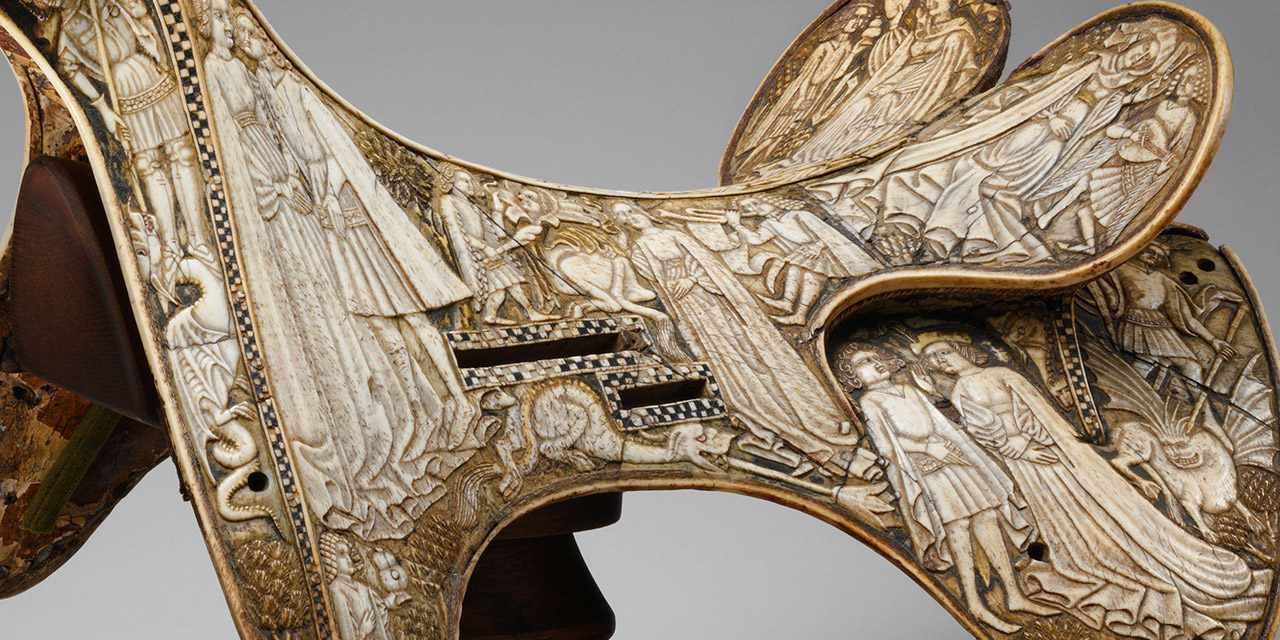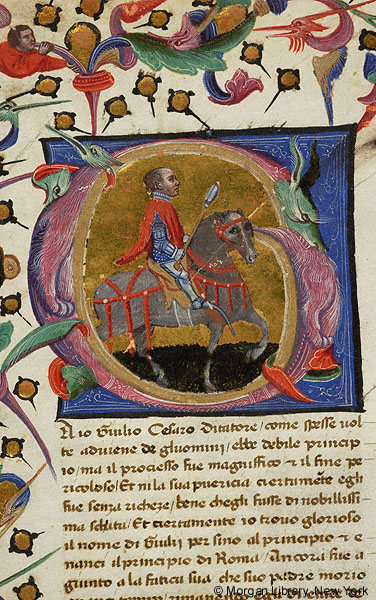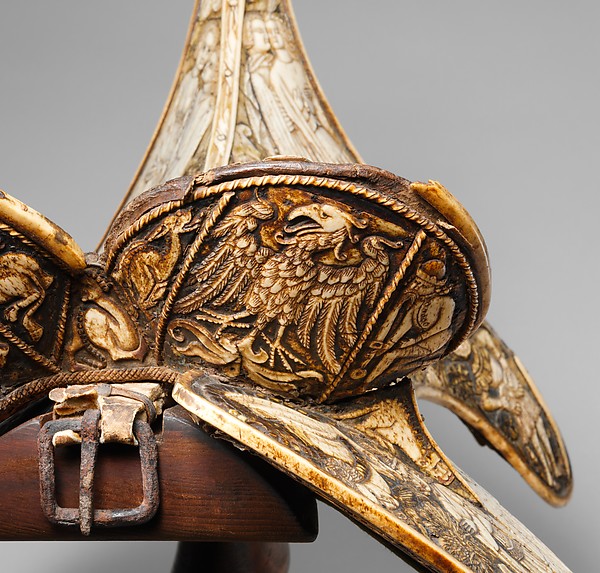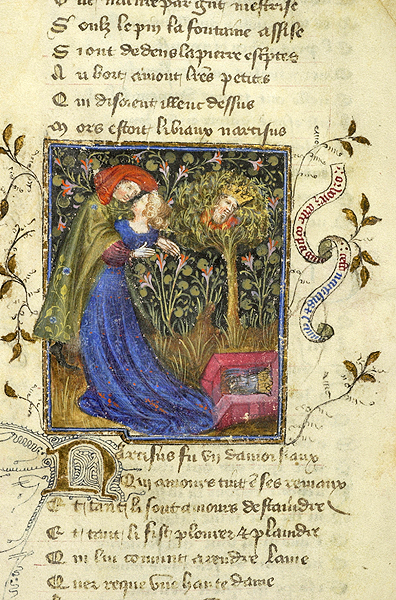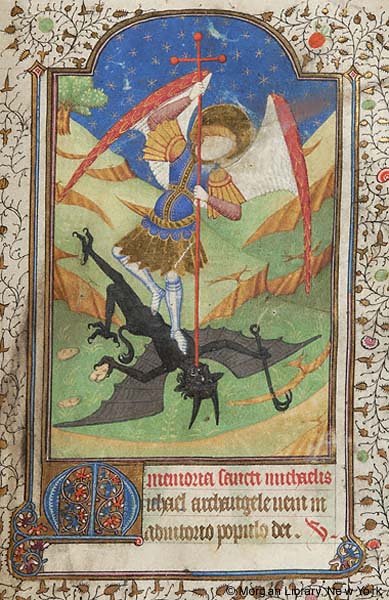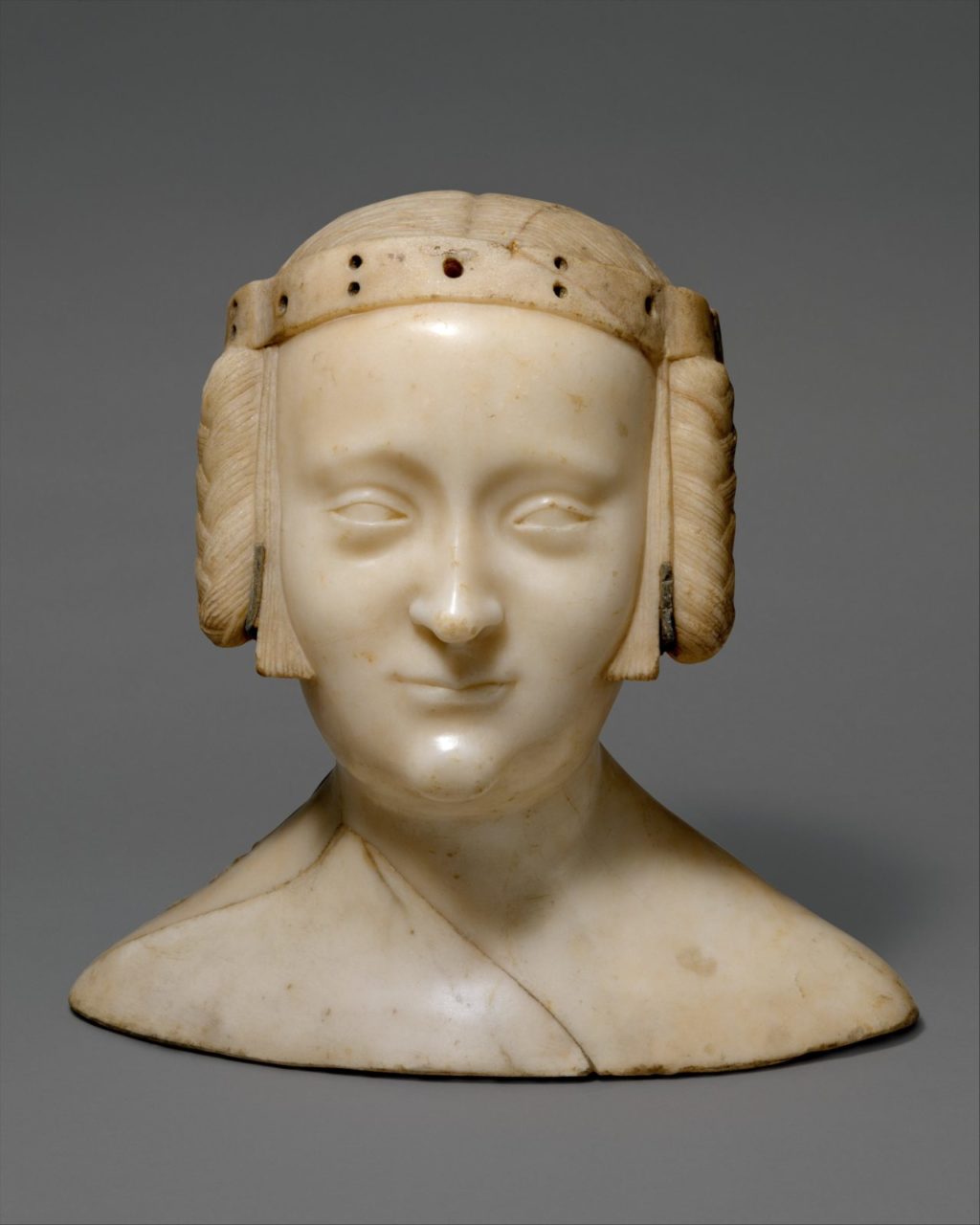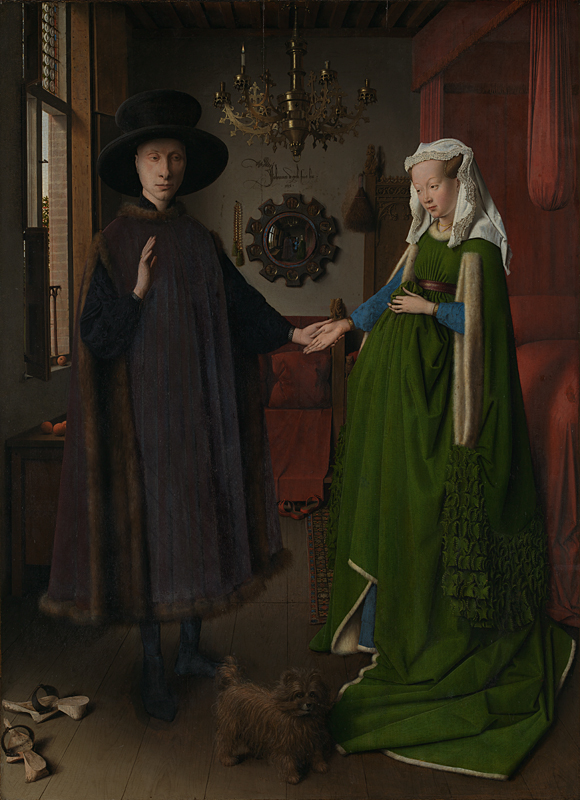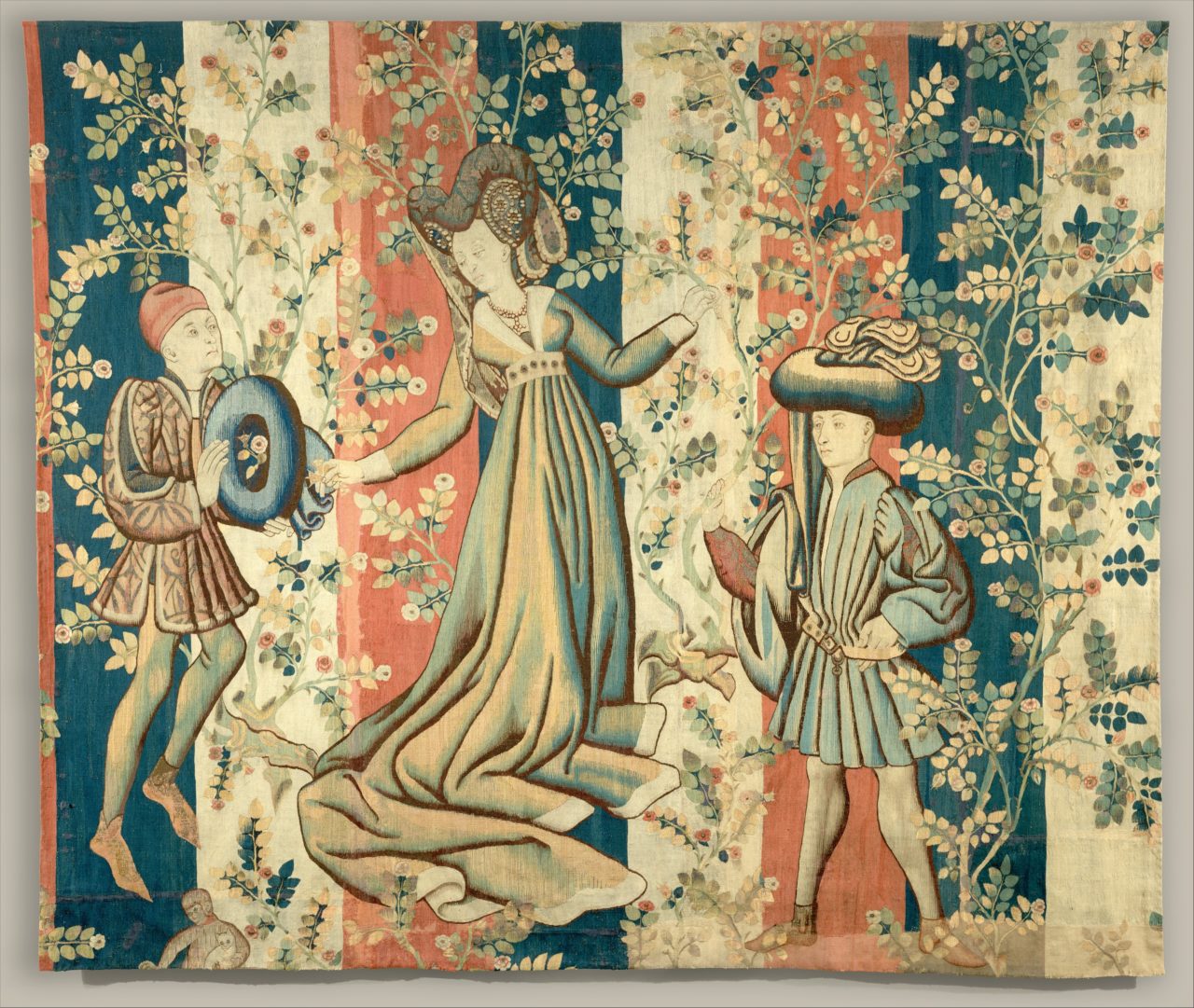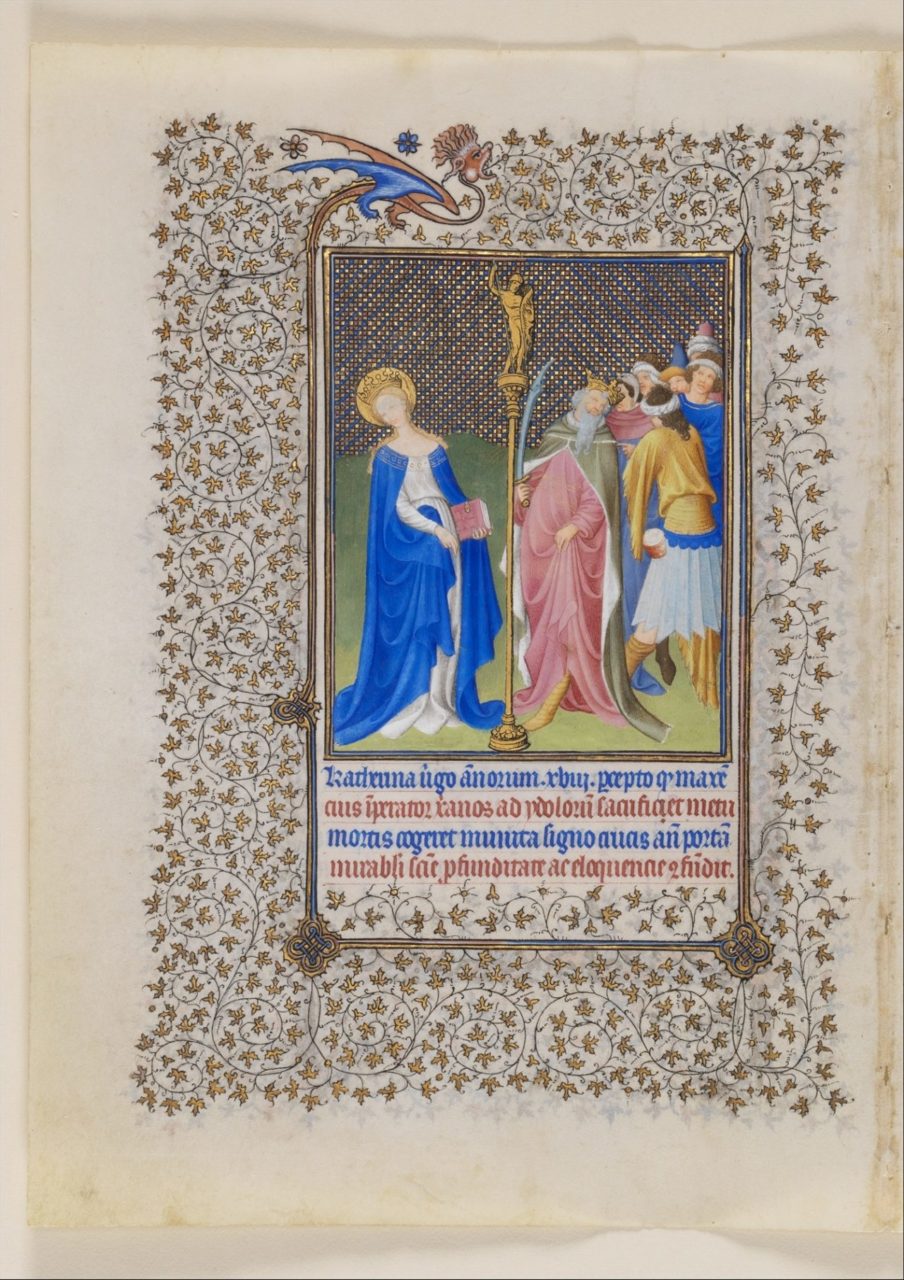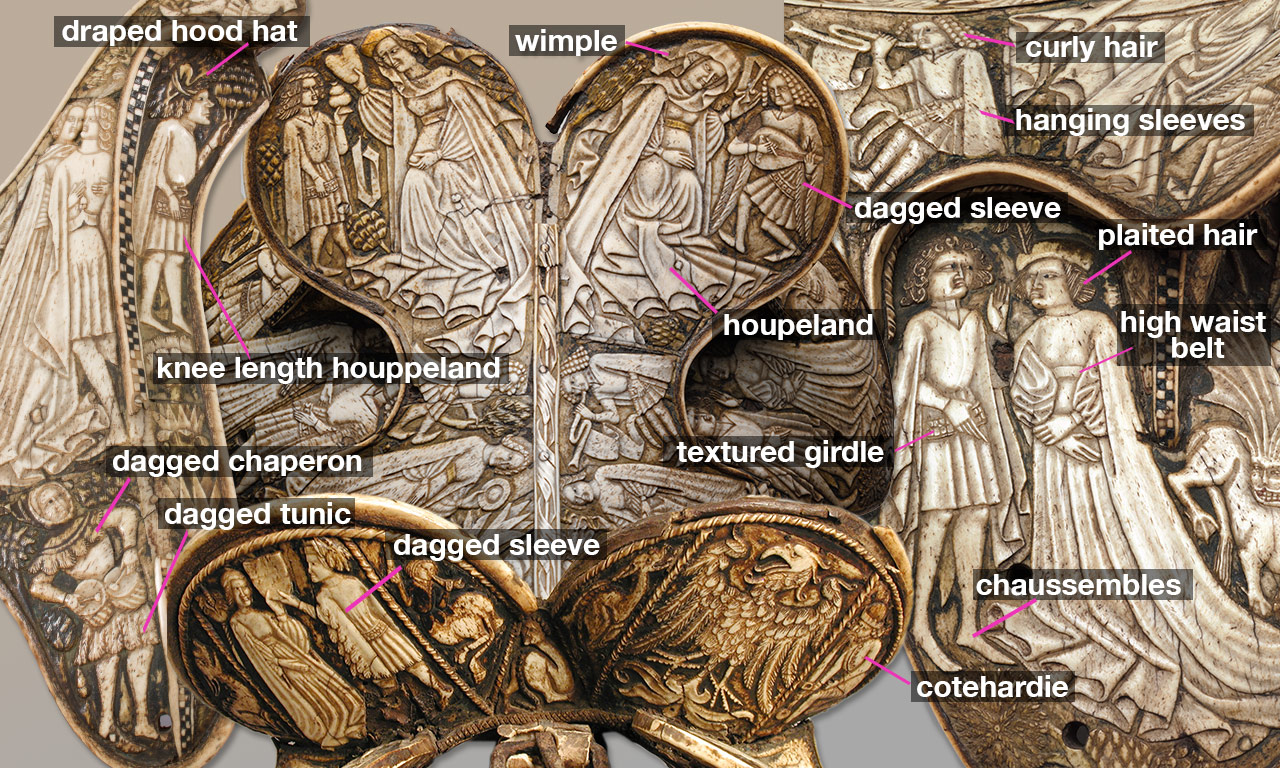This intricately carved medieval saddle, used ceremonially, celebrates life, love, the arts, and conquest of demons and dragons.
About the Artwork
This intricately carved staghorn saddle, constructed over a birchbark armature, and lined with rawhide, is one of a few surviving saddles from the early 15th century.
How was the saddle used?
If it seems uncomfortable to ride, it was mostly used “after battle in a triumphal procession,” according to Met curator Stephen Grancsay. The original “green, yellow and red” surface, has since faded away, but we can imagine it in a vibrant majestic parade, decked out like the horse in figure 1.
Where was the saddle made?
The Met names no specific artist, and, on its website, says that “perhaps” the saddle was made in Bohemia, ca. 1400- 1420. According to Wikipedia:
“Bohemia was … a kingdom in the Holy Roman Empire…. After World War I … Bohemia became a part of Czechoslovakia.”
Barbara Drake and Jirí Fajt, authors of Prague: The Crown of Bohemia (2005), go further to say that the materials and construction of this saddle conform to Bohemian and German saddlemakers in the late 14th and early 15th centuries, and that standards were set by the Order of Saddle Makers in the Prague New Town. Saddles made by Bohemian saddlers lined theirs with birch, like this one (Fig. 2), and constructed carved staghorn saddles in the same way as this one, which were used uncovered by blankets.
A flaming eagle motif can clearly be seen on the back of the saddle (Fig. 3). This symbol was the coat of arms of Wenceslaus I, Duke of Bohemia, according to Wikipedia. Drake and Fajt say that this symbol would only have been used by Wenceslaus IV, on or about 1400. All of these clues point to Bohemia, around 1400, on the earlier end of the Met’s date.
Fig. 1 - Cristoforo Cortese (Italian, 1304-1374). Libro degli uomini famosi, fol. 46v, 1405. Vellum; 30.8 x 23.1 cm (12.13 x 9.1 in). New York: Pierpont Morgan Library, MS G.36 fol. 46v. Gift of the Trustees of the William S. Glazier Collection, 1984. Source: Pierpont Morgan Library
Fig. 2 - Artist unknown (perhaps Bohemian). Underside of saddle, ca. 1400–1420. New York: The Metropolitan Museum of Art, 40.66a, b. Source: The Met
Fig. 3 - Artist unknown (Bohemian). Close-up of eagle on saddle, ca. 1400-1420. New York: The Metropolitan Museum of Art, 40.66a, b. Source: The Met
Artist unknown (perhaps Bohemian, Central European, ca. 1400-1420). Saddle. Staghorn, limewood, rawhide, birchbark, polychromy; 33.8 × 52.1 × 34.6 cm (13 5/16 × 20 1/2 × 13 5/8 in). New York: Metropolitan Museum of Art, 40.66a, b. Harris Brisbane Dick Fund, 1940. Source: The Met
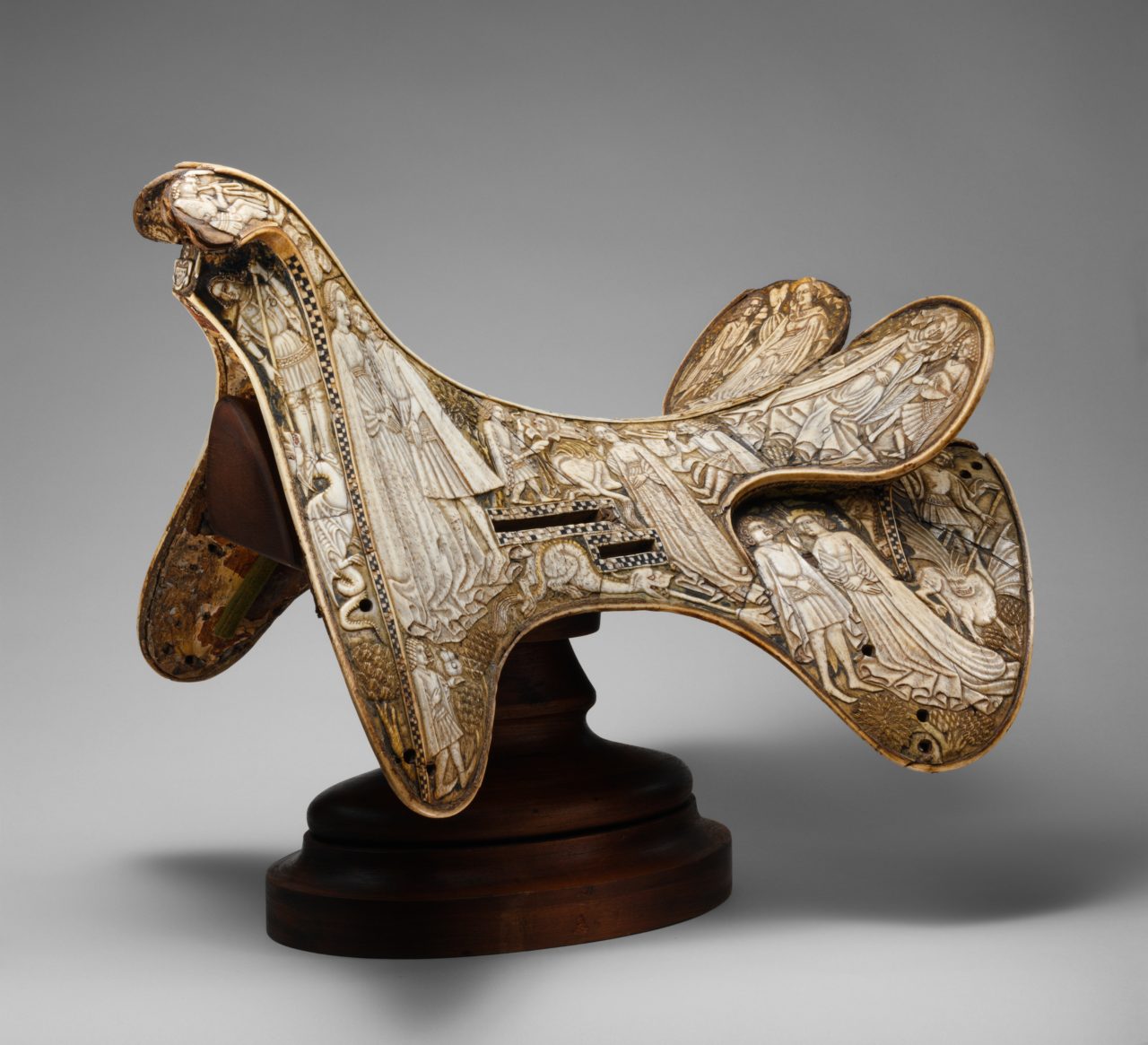
About the Fashion
T
he saddle is covered with intricate carvings of both men and women wearing a consistent style of costume throughout, similar in detail and style to other contemporary surviving artworks, especially illuminated manuscripts.
Common medieval subjects are seen on this saddle, such as courtly love, like the illumination in figure 4, and knights, like St. Michael slaying the dragons, as in the illuminated Book of Hours (Fig. 5).
Gendered dress
The women wear houppelandes that fall below their feet, with long hanging sleeves and arm slits revealing very full gathered sleeves, made with copious amounts of fabric, gathered into a high small waistline with a belt.
Men are dressed in tunics/ short houppelandes, with long dangling sleeves, often dagged, with low waistlines, v-necks in the front, low girdles/belts on knee-length pleated or dagged skirts. The king, seen next to the eagle, wears a cotehardie with a row of many buttons up the front.
The accessories
The women’s hairstyles appear to be elaborately plaited, framing the face. Figure 6 shows an example of a plaited hairstyle, although it is a bit earlier than this saddle, these plaited hairstyles were prevalent in the 15th century as well. Hairbands were often worn with the braided styles. Head coverings include long trailing veils, called wimples, and in at least one case, a feathered cap.
Older women here wear loose veils that cover their head, while “unmarried girls, brides and queens at their coronations could bare their heads and show their hair,” according to Tortora and Marcketti in The Survey of Historic Costume (169). At least one young woman wears a feathered cap over her plaits.
Men have very curly and long locks with headbands. One or two appear to wear a hat made from a draped hood. The musician or fool wears the more playful liripipe dagged chaperon and deeply dagged or slashed edges on the skirt of his tunic. The men wear hose attached to pointy shoes, called chaussembles. Almost all of the men have a textured, low girdle or wide belt that below the waist sits at hip level. Some of the men also carry purses attached to their belts.
Materials
Clothing from this period were mostly made from wool, although silk was also available. Weaving was done by men, usually belonging to weaving guilds, while women did the spinning and preparation of fibers, according to Tortora and Marcketti in The Survey of Historic Costume (126).
Stamped leather girdles with repeated rose or geometric patterns resembling the men’s belts carved here have been unearthed and catalogued in Dress Accessories, c. 1150 – 1450, by Geoff Egan, et al (41-45).
Fig. 4 - Guillaume de Lorris (French). Roman de la Rose, fol. 11r, 1405. Vellum; 28.5 x 21.0 cm (11.22 x 8.28 in). New York: Pierpont Morgan Library, MS M.245. Purchased by J. Pierpont Morgan (1837-1913) in 1900. Source: The Morgan Library
Fig. 5 - Artist unknown (French). Book of Hours, fol. 22r, 1420-25. Tempera on vellum; 26.7 x 18.4 cm (10.5 x 7.25 in). New York: The Morgan Library & Museum, MS M.105 fol. 22r. Source: The Morgan Library & Museum
Fig. 6 - Jean de Liège (French, active ca. 1361–died 1381). Tomb Effigy Bust of Marie de France (1327-41), daughter of Charles IV of France and Jeanne d'Evreux, ca. 1381. Marble with lead inlays; 31.1 x 32.4 x 15.7 cm (12 1/4 x 12 3/4 x 6 3/16 in). New York: The Metropolitan Museum of Art, 41.100.132. Gift of George Blumenthal, 1941. Source: The Met
Fig. 7 - Jan van Eyck (Dutch, active 1422; died 1441). Portrait of Giovanni(?) Arnolfini and his Wife, 1434. Oil on oak; 82.2 x 60 cm (32.4 x 23.6 in). London: The National Gallery, NG186. Bought, 1842. Source: The National Gallery
Fig. 8 - Artist unknown (South Netherlandish). Courtiers in a Rose Garden: A Lady and Two Gentlemen, ca. 1440–50. Wool warp; wool, silk, metallic weft yarns; 288.9 x 325.1 cm (9 ft. 5 3/4 in x 10 ft. 8 in). New York: The Metropolitan Museum of Art, 09.137.2. Rogers Fund, 1909. Source: The Met
The setting & context
There are many different kinds of figures carved on this saddle, showing men and women in typically medieval scenes, some everyday and some heroic or symbolic, meant to be understood by everyone, either literate or not.
Men and women hold hands and hearts to show their love, angels blow horns with flowing banners, musicians or fools entertain, “to make sport or to speak truth,” and knights confront strange beasts, perhaps demons. Met curator Stephen Grancsay notes:
“It was one of the principal duties of devils to annoy saints.”
The figures seem to fit with the idea of a ceremony, they conquer and they communicate love. They appear to be idealized. These are happy celebratory scenes.
The ideal
Grancsay goes on to note that “the men and women represented show the same long yellow curls that are credited in fourteenth-century paintings to angels and to youths and maidens… Costume features… are in the very extreme of fashion,” evidenced by the small waistlines, the men’s very long pointed shoes, and also by the women, shown with their hands over full looking bellies, an ideal of the period also reflected in Jan van Eyck’s Arnolfini Portrait (Fig. 7).
The fashion
While very few actual garments survive from the early 15th century, the style of dress depicted so beautifully in this carved saddle can be seen in many artworks from this time. The tapestry in figure 8 shows a similar style of dress. Illuminated manuscripts, like figures 9 and 10 also show similar styles that show a love of color not always obvious in other artworks more faded with age.
Fig. 9 - The Limbourg Brothers (Franco-Netherlandish, active France, by 1399–1416). The Belles Heures of Jean de France, duc de Berry, 1405–1408/1409. Tempera, gold, and ink on vellum; 23.8 x 17 cm (9 3/8 x 6 11/16 in). New York: The Metropolitan Museum of Art, 54.1.1a, b. The Cloisters Collection, 1954. Source: The Met
Dagging
Multiple examples of dagging on men’s garments are in the carvings. In the book, Clothing and Culture, 1350-1650, Chapter 15, “Rips and Slits: The Torn Garment and the Medieval Self,” Andrea Denny-Brown has some interesting insights about this fashion feature. On page 224, she states that “chroniclers condemned,” and “sumptuary legislation regulated ‘slashings, jagged edges or fripperies’ according to gender and social status.”
There are various theories about the significance of dagged edges, from associations with “ambivalent figures,” or links to “knightly attire,” or being related to daggers (228). However, slashed garments continue until this day, and are associated with “a sense of visceral excitement, adrenaline, and danger: the equivalent of today’s motorcycle jacket” (237).
Fig. 10 - Gaston Phébus (French). Livre de la Chasse, fol. 66r, 1410. Vellum; 38.5 x 28.7 cm (15.2 x 11.3 in). New York: The Morgan Library & Museum, MS M.1044 fol. 66r. Dr. A. S. W. Rosenbach. Source: The Morgan Library
References:
- Allen, Nicole, and Gregory Mele. Book of Historic Fashions: A Newcomer’s Guide to Medieval Clothing, 1300-1450. Wheaton, IL : Freelance Academy Press, 2014. http://www.worldcat.org/oclc/903635989.
- “Bohemia.” Wikipedia, December 4, 2017. https://en.wikipedia.org/w/index.php?title=Bohemia&oldid=813728906.
- Buren, Anne van, and Roger S Wieck. Illuminating Fashion: Dress in the Art of Medieval France and the Netherlands 1325-1515. London: Giles, 2012. http://www.worldcat.org/oclc/931839789.
- Drake, Barbara, and Jirí Fajt. Prague: The Crown of Bohemia, 1347-1437. New York: The Metropolitan Museum of Art ; Yale University Press, 2005. http://www.worldcat.org/oclc/959146421.
- Egan, Geoff, and Frances Pritchard. Dress Accessories, c. 1150 – c. 1450. Rochester, NY: Boydell Press, 2010. http://www.worldcat.org/oclc/854563214.
- Gathercole, Patricia M. The Depiction of Clothing in French Medieval Manuscripts. Lewiston, NY: Edwin Mellen Press, 2008. http://www.worldcat.org/oclc/907179826.
- Grancsay, Stephen V. “A Mediaeval Sculptured Saddle.” The Metropolitan Museum of Art Bulletin 36, no. 3 (1941): 73–76. https://doi.org/10.2307/3256256.
- Hill, Daniel Delis. History of World Costume and Fashion. Boston: Prentice Hall, 2011. http://www.worldcat.org/oclc/731445106.
- Randall, Richard H. The Golden Age of Ivory: Gothic Carvings in the North American Collections. New York: Hudson Hills Press, 1993. http://www.worldcat.org/oclc/716534035.
- Richardson, Catherine. Clothing Culture, 1350-1650. Burlington, VT: Ashgate, 2004. http://www.worldcat.org/oclc/270969802.
- “Saddle | Central European | The Met.” The Metropolitan Museum of Art, i.e. The Met Museum. Accessed December 6, 2017. https://www.metmuseum.org/art/collection/search/467691.
- Tortora, Phyllis G., and Sara B. Marcketti. Survey of Historic Costume. London: Bloomsbury, 2015. http://www.worldcat.org/oclc/967772873.
- “Wenceslaus I, Duke of Bohemia.” Wikipedia, November 23, 2017. https://en.wikipedia.org/w/index.php?title=Wenceslaus_I,_Duke_of_Bohemia&oldid=811755304.

